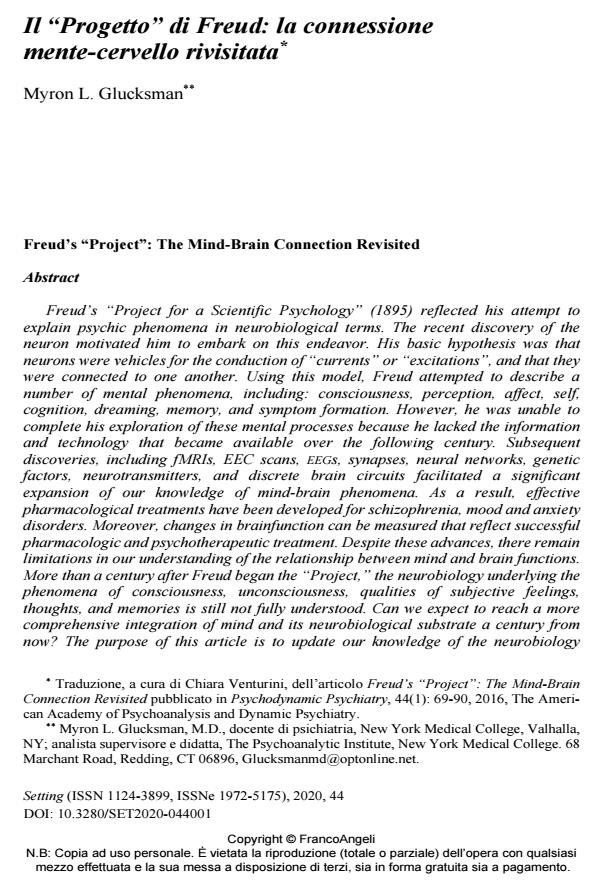Freud’s "Project": The Mind-Brain Connection Revisited
Journal title SETTING
Author/s Myron L. Glucksman
Publishing Year 2021 Issue 2020/44
Language Italian Pages 26 P. 5-30 File size 342 KB
DOI 10.3280/SET2020-044001
DOI is like a bar code for intellectual property: to have more infomation
click here
Below, you can see the article first page
If you want to buy this article in PDF format, you can do it, following the instructions to buy download credits

FrancoAngeli is member of Publishers International Linking Association, Inc (PILA), a not-for-profit association which run the CrossRef service enabling links to and from online scholarly content.
Freud’s "Project for a Scientific Psychology" (1895) reflected his attempt to explain psychic phenomena in neurobiological terms. The recent discovery of the neuron motivated him to embark on this endeavor. His basic hypothesis was that neurons were vehicles for the conduction of "currents" or "excitations", and that they were connected to one another. Using this model, Freud attempted to describe a number of mental phenomena, including: consciousness, perception, affect, self, cognition, dreaming, memory, and symptom formation. However, he was unable to complete his exploration of these mental processes because he lacked the information and technology that became available over the following century. Subsequent discoveries, including fMRIs, EEC scans, EEGs, synapses, neural networks, genetic factors, neurotransmitters, and discrete brain circuits facilitated a significant expansion of our knowledge of mind-brain phenomena. As a result, effective pharmacological treatments have been developed for schizophrenia, mood and anxiety disorders. Moreover, changes in brainfunction can be measured that reflect successful pharmacologic and psychotherapeutic treatment. Despite these advances, there remain limitations in our understanding of the relationship between mind and brain functions. More than a century after Freud began the "Project," the neurobiology underlying the phenomena of consciousness, unconsciousness, qualities of subjective feelings, thoughts, and memories is still not fully understood. Can we expect to reach a more comprehensive integration of mind and its neurobiological substrate a century from now? The purpose of this article is to update our knowledge of the neurobiology associated with the specific mental functions that Freud examined in the "Project", and to pose questions concerning mind-brain phenomena that will hopefully be answered in the future.
Keywords: Consciousness; memory; hysteria; conversion; cognition; affect; mentalization; mirror neurons.
Myron L. Glucksman, Il "Progetto" di Freud: la connessione mente-cervello rivisitata in "SETTING" 44/2020, pp 5-30, DOI: 10.3280/SET2020-044001